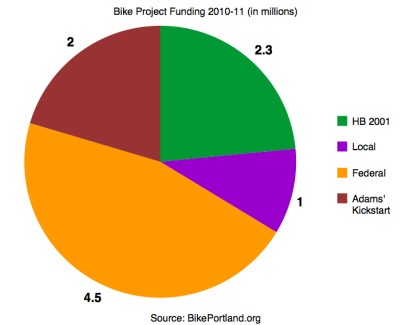
(Graph: BikePortland/Source info: PBOT)
In the fiscal year that runs from June 2010 through July 2011, the Bureau of Transportation will have $14 million in new state revenue to spend thanks to the passage of HB 2001, the “Jobs and Transportation Act,” by legislators last year.
Back in January I delved into where they might spend that money, but now that they’ve released their official budget request to the Office of Management and Finance, I thought I’d share the detailed figures.
First, for a bit of perspective, the total PBOT budget request for 2010-11 is $245 million (13.4% of the total City budget). Of that $245 million, PBOT spends just over half ($133 million) on “capital improvements,” a.k.a. physical infrastructure. The rest is split into “operations,” “maintenance,” and “administration & support.”
Today I’ll focus on the $14 million from HB 2001. Here’s where PBOT wants to spend that money (keep in mind that PBOT is basing these priorities on decisions reached by the Safe, Sound and Green Streets stakeholder committee back in 2008):
High Crash Corridor Program – $300,000
This money would go toward improving traffic safety on 10 busy arterial streets that have a history of crash activity. Funds would go toward “low cost traffic control improvements” ($30,000 per corridor won’t go very far) as well as enforcement and educational efforts. (Since PBOT uses DMV data, these high-crash corridors only include motor vehicle collisions.)
Pedestrian Safety Improvements – $400,000
“Improvements will provide enhanced crossings, pedestrian refuge islands, and other pedestrian safety improvements where appropriate.”
Safe Routes to Schools Improvements – $230,000
This money will be spent on at least two schools that will receive “crossing improvements, traffic control changes, traffic calming measures, green street features” and so on.
Pedestrian & Bike Safety Corridors (Affordable Transportation) – $1,000,000
There are six specific projects listed to receive funding. They are:
- NE 12th Ave. Overcrossing – Crossing improvements from NE Irving to NE Lloyd over I-84 near Lloyd Center.
- 15 Miles of Bike Blvd – This money will help leverage other funds to help build seven new bicycle boulevards on 87th Ave., N. Central, 101st Ave., SE Bush, NE Klickitat, NE Holman, and SW Illinois/Vermont.
- Cycle Track Development – “Two cycle track treatments at high volume locations.” Locations mentioned are N. Williams – Vancouver and NE Holladay St.
- NE Glisan Buffered Bike Lane – From NE 22nd to NE 32nd.
- Rose Quarter – “Additional pavement markings, signage, striping, and possible crossing improvement alternatives for additional bicycle and pedestrian access to the Rose Quarter.”
- SW Terwiliger-PSU Access Improvements – “Design and implement connections from SW into downtown Portland.”

the pavement for the future
bike boulevard on N. Going.
(Photo © J. Maus)
Arterials with no Sidewalks – $639,000
These projects will focus on areas where sidewalks don’t exist and access to transit is needed.
Streetlight Replacement – $500,000
Arterial Streets – Contract Paving – $3,412,000
This money will be used for “curb-to-curb” road rehab and pavement in-lay. The focus in 2010-11 will be NE Sandy Blvd. between NE 42nd and NE 82nd Avenues.
Trip Reduction Program – $100,000
This would expand the amount of households that can be served by PBOT’s SmartTrips individualized marketing program that aims to reduce single-occupancy vehicle use.
Deficient Bridges/Overpasses (non-Willamette River bridges) – $1,000,000
This funding will go toward some of the City’s “poor and weight restricted bridges which are currently prohibiting the movement of freight and transit.”
City and Regional Priority CIP Match – $4,000,000
This money will go toward matching federal and state money that is coming to Portland for already approved projects. Below is the list of project and the amount of HB 2001 that will be put toward them (total project cost in parentheses):
- SW Gibbs St. Pedestrian Bridge – $2,000,000 ($13.6 million)
- SW Harbor River Parkway Intersection – $1,000,000 ($5.4 million)
- SW Moody: River Pkwy – $400,000 ($24.4 million)
- Bancroft/Hood/Macadam – $100,000 ($100,000)
- St. Johns Truck & Ped – $500,000 ($2.6 million): This project will “construct pedestrian crossing improvements in conjunction with freight mobility improvements” in St. Johns Town Center.
Signal Rehab & Signal Optimization Program – $500,000
“This project would replace aging traffic signal infrastructure and/or optimize traffic signal operations with signal timing modifications or adaptive traffic control systems.”
Smartmeter Debt Service – $2,058,000
Funds would go toward paying off debts to replace parking paystations.
According to my unscientific estimate, about $2.15 million of PBOT’s $14 million in HB 2001 money will be spent on bike-specific projects. Add to that about $1 million in local funds (from traffic citation and parking revenue along with grants from other agencies), $4.5 million in federal funds, and a $2 million per year “kickstart” fund coming from Mayor Adams, and PBOT is on course to spend almost $10 million on bike projects in the coming fiscal year — about 7.5 percent of their total capital improvement budget.
If you’d like to learn more about the budget process, check out the City’s Community Budget website and plan to attend one of three upcoming Community Budget Forums (3/1, 3/3, or 3/6).

